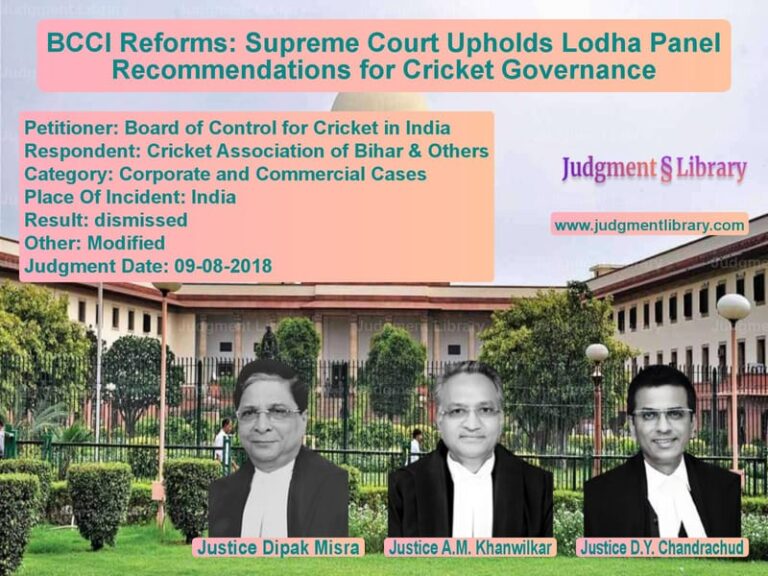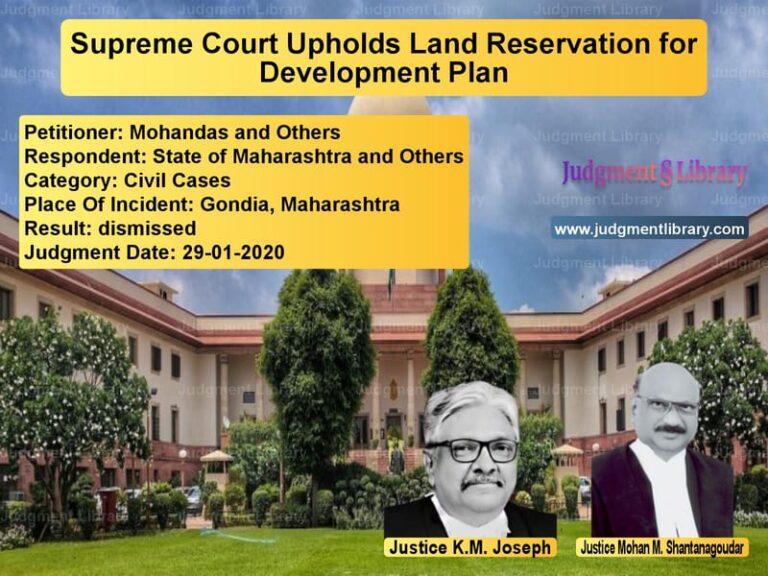Reinstatement of Employees in Government Service: Supreme Court Ruling in Haridas v. Director, U.P. Education for All Project
Introduction
The case of Haridas v. Director, U.P. Education for All Project pertains to the reinstatement and absorption of employees who were previously associated with the Cement Corporation and later sought employment within the government sector. The Supreme Court examined whether these employees were entitled to similar treatment as those in an earlier case where reinstatement was granted with limited back wages. This ruling underscores the principles of equality in employment policies and highlights the procedural obligations of government authorities when dealing with reinstatement claims.
Background of the Case
The appellants, including Haridas, had been employed under the U.P. Education for All Project (Sarva Shiksha Abhiyan). They claimed that they were similarly placed as the appellants in Civil Appeal Nos. 9165-9172 of 2010, which the Supreme Court had decided on September 9, 2015. In that judgment, the Supreme Court ruled that the State Government must absorb employees who had lost their jobs due to institutional closure or policy changes, subject to conditions.
However, due to a long break in employment, the Supreme Court in the earlier case limited the claim for back wages to 40%. The appellants in the present case contended that they too should receive the same benefits as per the 2015 ruling.
Legal Issues Raised
- Were the appellants entitled to reinstatement in government service, similar to the employees in the 2015 case?
- Should the government have considered their case for absorption without requiring fresh litigation?
- Did the High Court err in not considering the precedent set by the Supreme Court in the earlier case?
Arguments by the Appellants
- The appellants were similarly situated to the employees in the 2015 case and should be given the same treatment.
- Their employment had been terminated without due process, and the government had an obligation to reinstate them.
- The delay in seeking reinstatement should not be held against them as their right to employment was being unfairly denied.
Arguments by the Respondents (Director, U.P. Education for All Project)
- The appellants had been out of service for a long time, which created practical difficulties in reinstatement.
- The High Court had correctly dismissed their plea as they had not filed their claims on time.
- Employment policies and administrative feasibility should be considered before granting relief.
Supreme Court’s Judgment
The Supreme Court ruled in favor of the appellants, stating that the High Court had not considered the precedent set in the 2015 judgment. The Court held:
“The appellants claim that they are similarly situated as the appellants in Civil Appeal Nos. 9165-9172 of 2010, which were disposed of by judgment dated 09.09.2015. This Court has taken the view that the State Government was to absorb the employees of the Cement Corporation.”
Further, the Court directed the respondents to examine the appellants’ claims in light of the 2015 ruling:
“The respondents are directed to consider the cases of the appellants also in the light of the judgment in Civil Appeal Nos. 9165-9172 of 2010 and in case the appellants herein are also similarly situated as the appellants therein, similar treatment shall be given to the appellants herein as well.”
Key Takeaways from the Judgment
- Equal Treatment Under Law: Employees in similar situations should not be denied relief based on procedural technicalities.
- Precedent Matters: The ruling reaffirmed that government authorities must apply previous judgments when handling similar cases.
- Reinstatement with Conditions: While the appellants were granted relief, the court acknowledged that practical challenges may require modifications, such as limiting back wages.
Implications of the Judgment
The ruling serves as a crucial precedent for employees seeking reinstatement after termination due to policy changes. It ensures that:
- Government employees who were unfairly dismissed or not absorbed are entitled to a fair review of their case.
- Administrative authorities must consider Supreme Court rulings while making employment decisions.
- Reinstatement claims cannot be arbitrarily dismissed without evaluating individual circumstances.
Conclusion
The Supreme Court’s ruling in Haridas v. Director, U.P. Education for All Project ensures that similarly placed employees receive equal treatment in government absorption policies. It reinforces that judicial precedents must be followed and that procedural delays should not be used to deny legitimate claims. The decision strengthens employees’ rights while recognizing administrative constraints in implementing large-scale employment absorption.
Don’t miss out on the full details! Download the complete judgment in PDF format below and gain valuable insights instantly!
Download Judgment: Haridas vs Director, U.P. Educa Supreme Court of India Judgment Dated 20-01-2017.pdf
Direct Downlaod Judgment: Direct downlaod this Judgment
See all petitions in Employment Disputes
See all petitions in Judgment by Kurian Joseph
See all petitions in Judgment by A M Khanwilkar
See all petitions in allowed
See all petitions in Remanded
See all petitions in supreme court of India judgments January 2017
See all petitions in 2017 judgments
See all posts in Service Matters Category
See all allowed petitions in Service Matters Category
See all Dismissed petitions in Service Matters Category
See all partially allowed petitions in Service Matters Category







